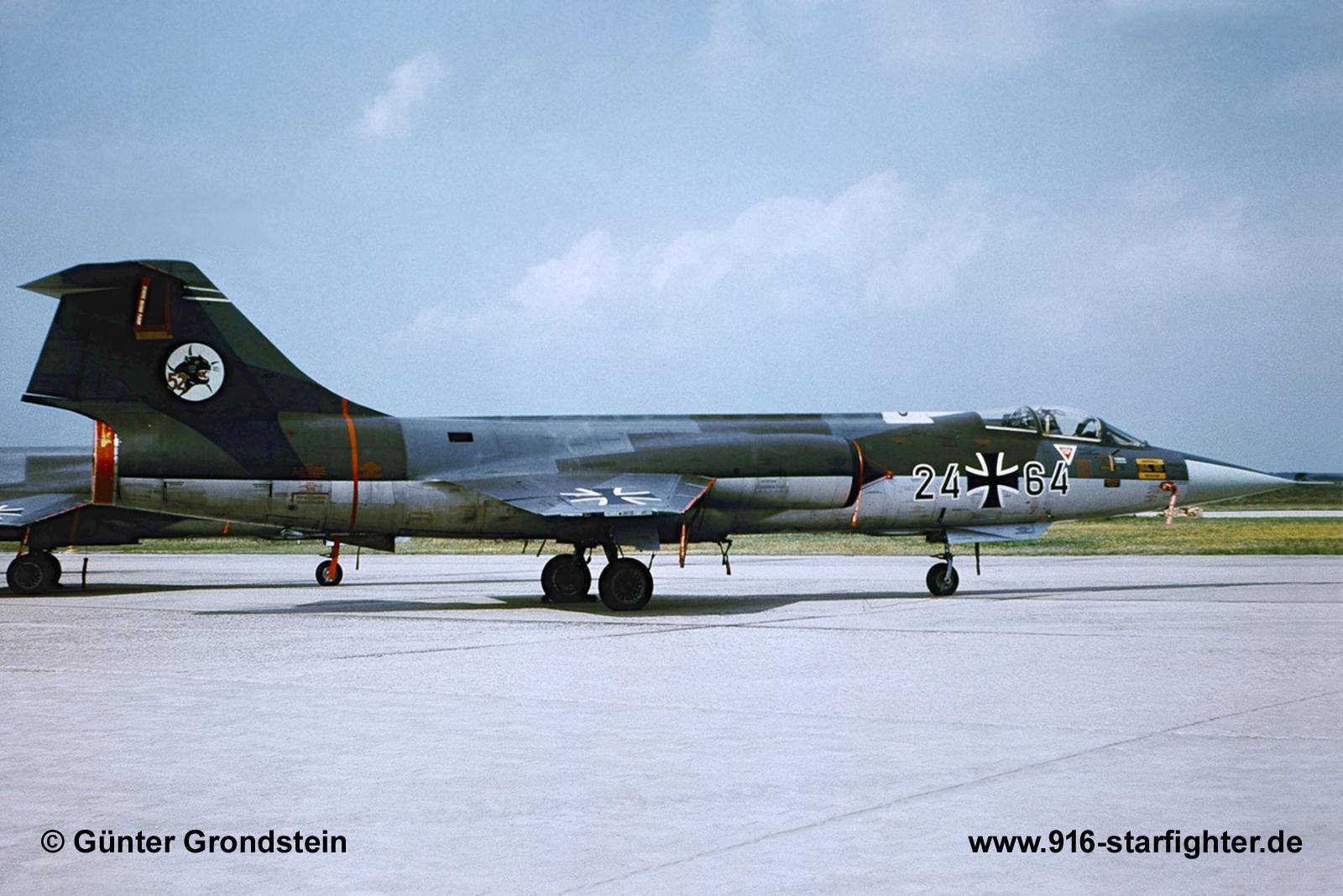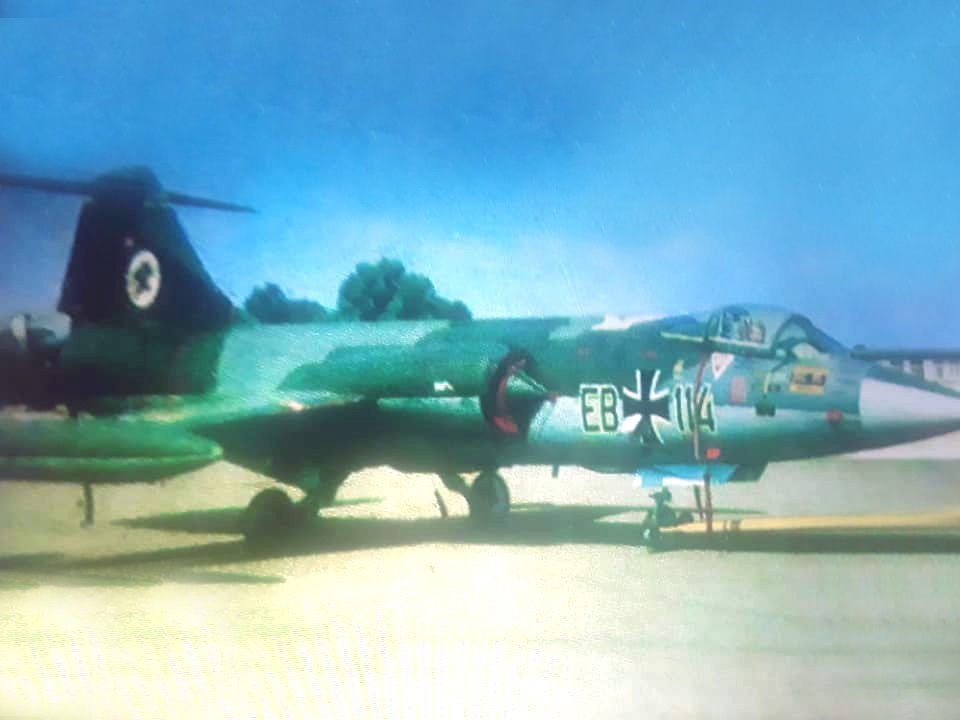
RF-104G 24+64 AG 52 at Husum AB 1970
RF-104G, construction number 683D-8213, company model 683-04-10, built by Fokker
manufactured by North Group (ARGE-Nord); first flight January 30, 1964 coded KG+313 at Fokker-Schiphol
January 30, 1964 to Avio Diepen for RF-104G modifications according project "Recce"; March 5, 1964 to Fokker for camouflage scheme "Norm 62" according tech order "TA-196"
acceptance date by BABwFokker (RNAF-MTA) April 16, 1964 with 4:45 flight hours; LVR 3 (Luftwaffenversorgungsregiment 3) on April 27, 1964 for technical upgrading
EB+114 AG 52 at Leck AB delivery date on November 5, 1964; IRAN at SABCA July 8, 1966 with 170 flight hours, back to AG 52 on April 18, 1967
24+64 WaSLw 10 on September 20, 1971; modified to AWX (All Weather Fighter) version F-104G on November 18, 1971; JG 74 on May 30, 1972
MFG 1 (Marine Air Wing 1) at Schleswig-Jagel AB on July 8, 1974; struck off charge order (AVA) December 4, 1973
WaSLw 10 on June 26, 1975 for NASA pilot training with 1.671 flight hours; ferry flight from June 27, until July 2, 1975 together with construction number 5735 and 5739
via RAF Lossiemouth to Dryden Flight Research Center at Edwards AFB, CA; arrived at Dryden flown by Gary Krier.
 NASA 826 [N826NA] aeronautical experiments testbed at Dryden Flight Research Center, Edwards AFB, California.
Last research mission with NASA 826 was on January 31, 1994. Last flight February 3, 1994 as last NASA F-104
A symbolic farewell with NASA 826 is piloted by Tom McMurtry, Chief Flight Operations Division.
Preserved at Dryden Flight Research Center, Edwards, California from July 1995; on display at NASA Dryden Flight Research Facility in Visitor Center, Edwards, California; August 2024 noted.
Project "Recce": 66 RF-104G from ARGE-Nord, which were converted to RF-104G before delivery. They were intended for the second squadron of WaSLw 10, AG 51, AG 52 and project Columbus.
copyright © GŁnter Grondstein
NASA 826 [N826NA] aeronautical experiments testbed at Dryden Flight Research Center, Edwards AFB, California.
Last research mission with NASA 826 was on January 31, 1994. Last flight February 3, 1994 as last NASA F-104
A symbolic farewell with NASA 826 is piloted by Tom McMurtry, Chief Flight Operations Division.
Preserved at Dryden Flight Research Center, Edwards, California from July 1995; on display at NASA Dryden Flight Research Facility in Visitor Center, Edwards, California; August 2024 noted.
Project "Recce": 66 RF-104G from ARGE-Nord, which were converted to RF-104G before delivery. They were intended for the second squadron of WaSLw 10, AG 51, AG 52 and project Columbus.
copyright © GŁnter Grondstein



 NASA 826 [N826NA] aeronautical experiments testbed at Dryden Flight Research Center, Edwards AFB, California.
Last research mission with NASA 826 was on January 31, 1994. Last flight February 3, 1994 as last NASA F-104
A symbolic farewell with NASA 826 is piloted by Tom McMurtry, Chief Flight Operations Division.
Preserved at Dryden Flight Research Center, Edwards, California from July 1995; on display at NASA Dryden Flight Research Facility in Visitor Center, Edwards, California; August 2024 noted.
Project "Recce": 66 RF-104G from ARGE-Nord, which were converted to RF-104G before delivery. They were intended for the second squadron of WaSLw 10, AG 51, AG 52 and project Columbus.
copyright © GŁnter Grondstein
NASA 826 [N826NA] aeronautical experiments testbed at Dryden Flight Research Center, Edwards AFB, California.
Last research mission with NASA 826 was on January 31, 1994. Last flight February 3, 1994 as last NASA F-104
A symbolic farewell with NASA 826 is piloted by Tom McMurtry, Chief Flight Operations Division.
Preserved at Dryden Flight Research Center, Edwards, California from July 1995; on display at NASA Dryden Flight Research Facility in Visitor Center, Edwards, California; August 2024 noted.
Project "Recce": 66 RF-104G from ARGE-Nord, which were converted to RF-104G before delivery. They were intended for the second squadron of WaSLw 10, AG 51, AG 52 and project Columbus.
copyright © GŁnter Grondstein


